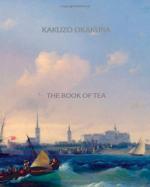|
This section contains 547 words (approx. 2 pages at 400 words per page) |

|
Teaism
Teaism is the art of the tea ceremony. It incorporates many different disciplines, from tea brewing to hygiene to flower arrangement to architecture.
Ch'a Ching
Ch'a Ching, or the Code of Tea, was written by poet Lu Wu and it stands as the first attempt to codify the tea ceremony and explain its larger significance.
Taoism
Taoism, a philosophy invented by Lao Tzu that spread throughout South China, emphasizes the individual rather than society, and is suspicious of organizations like religion and the state. It focuses on the here and now and the potential of things, the "path" rather than the end destination. Much of Teaism is based upon ideas in Taoism.
Confucianism
Confucianism is considered as an opposite to Taoism, a philosophy that dominated North China. It emphasizes order and the community. Taoism cannot be fully understood without knowledge of Confucianism, and visa versa.
Lao Tzu's Vacuum
|
This section contains 547 words (approx. 2 pages at 400 words per page) |

|




